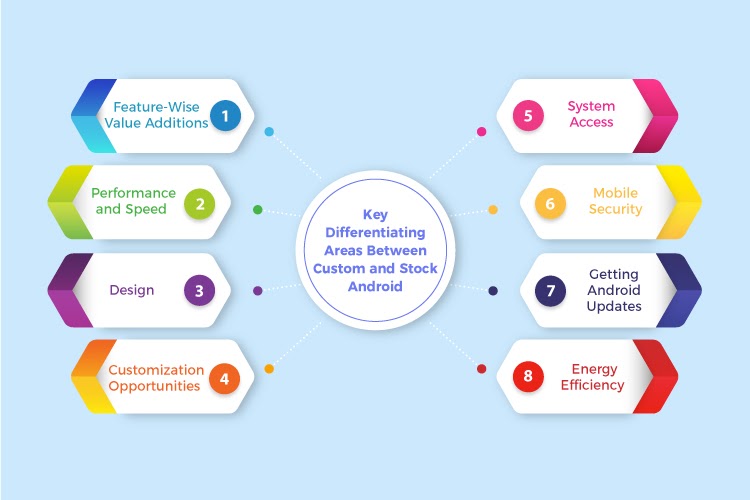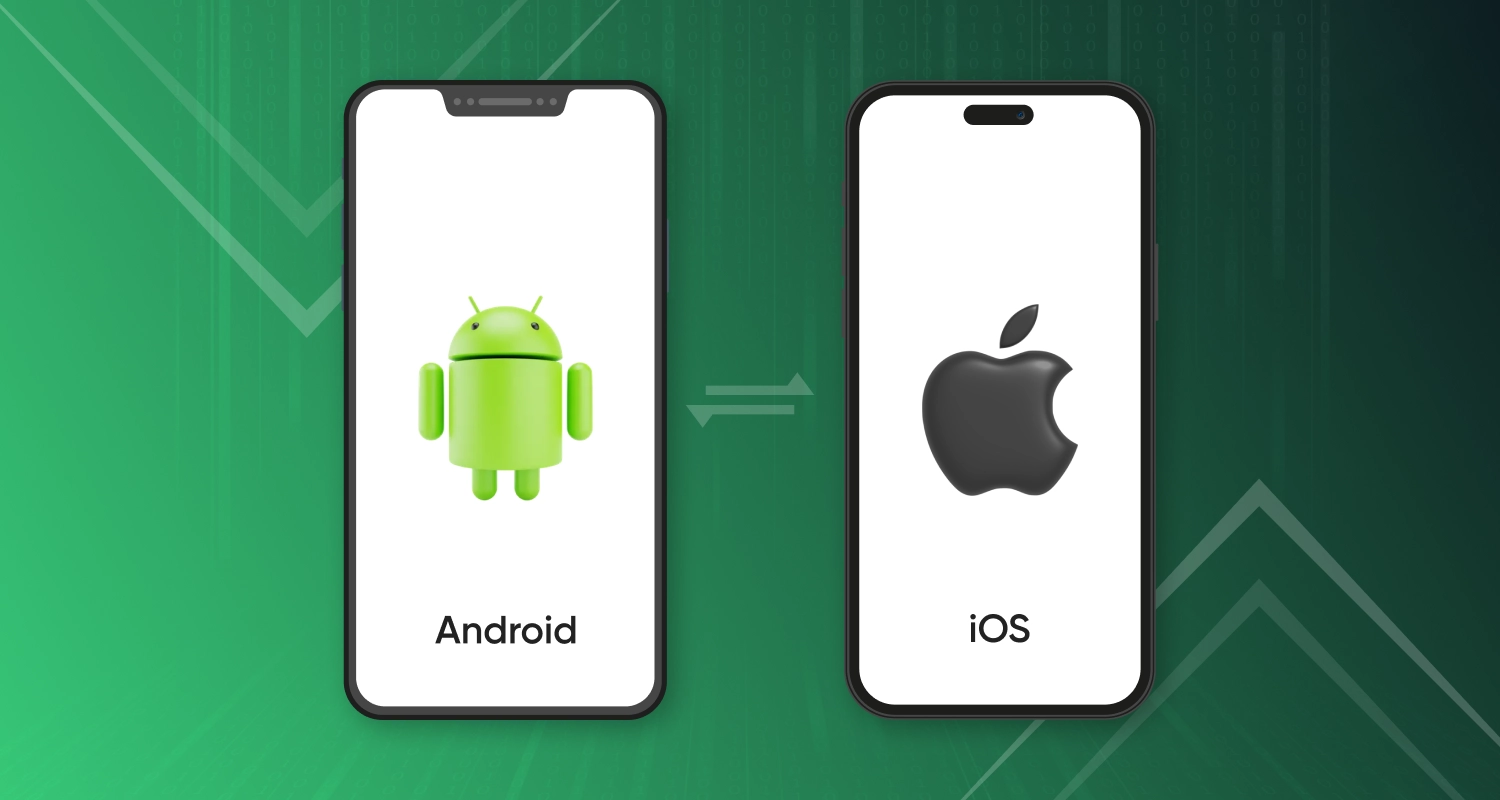Stock android is the google envisioned android version and the other side in Custom UI companies can make changes in the android OS as that is open source. In this blog, you will get more differences and solutions to keep an eye for any android app development services company.
Android is the leading mobile operating system or mobile platform with a presence across most expansive range of mobile devices. As Android offers a multitude of versions running across multiple devices different in capabilities and features, it is also regarded as the most versatile platform. Since new flagship phones keep coming in the Android ecosystem, there is a greater demand for tweaking the user experience with custom attributes from the device manufacturers. This is why custom Android operating systems became so popular.
On the other hand, all those app developers and device manufacturers who want to stick to Google’s UI guidelines all through their development projects, Stock Android still remains to be the ideal option. While Stock Android doesn’t offer much scope of customization, at least it helps developers to stay true to the essential user experience attributes of core Android UI as unleashed by Google. For Android development services, both of these Android versions are equally important.
With pros and cons on both sides of this device, Android development companies should have a clear idea about the key benefits and shortcomings of both Android versions.
What Exactly is Stock Android?
Stock Android actually means the original Android version released by Google and that follows Google’s official UI guidelines. It is the Android version with all UI elements developed and released by Google without any additional changes. Stock Android comes only loaded with all the UI attributes and features of the original Android version officially made available by Google. It comes as a pure and unadulterated Android version that doesn’t have any additional UI layer.
What Exactly is Custom Android?
Custom Android basically refers to the Android version coming with additional UI layer and custom UX elements for much-improved user experience on the Android platform. Custom Android experience is shaped by additional UX tweak, UI layers or third party applications on and above the core Android released by Google. This is shaped by adding extra features and additional interactive elements to the standard Android UI released by Google with the update.
Key Differentiating Areas Between Custom and Stock Android
Since we have a clear idea about the basic definition and the key characteristics of stock and custom android, it is time to understand the key differentiating areas between them.
Feature-Wise Value Additions and Third-Party Apps
There is no reason to think that devices running on stock android lack features and functionalities. The mobile phones running with stock android updates also provide the latest UI elements such as app launchers, app drawers, gestures, etc. By downloading third-party apps often these device users can fulfill their need or craving for extra features or UI elements.
In total contrast, most of the leading flagship Android phones prefer using custom Android UI for the sake of providing users a wide range of sophisticated UI elements and state of the art features and other value additions that are crucial to engaging user experience.
Performance and Speed
Considering the mobile app testing services quality practices, in terms of performance and speed, Stock Android has an edge over the custom Android versions simply because they by sticking to Google’s core UI guidelines actually conform to the performance expectations as tested by Google before releasing the update. This is why there are lesser chances for the stock Android to experience any bugs or performance issues.
In complete contrast, custom android UI is more prone to experience performance issues. Moreover, custom android UI is often pained by bugs and unwanted bottlenecks.
Design
We all know for the latest range of Android updates Google follows the Material design principle which has already gained the stamp of trust from countless apps and Android mobile devices. Stock Android by simply following this design principle, allows the users basic advantages of material design.
In complete contrast, custom Android UI is vulnerable to have loopholes or shortcomings when following the Material Design principle. Just because custom Android design ventures to create new designs with unvalidated design elements, it is more vulnerable to design glitches.
Customization Opportunities
When it is about the scope of customization, Stock Android has limited options just because it completely limits itself within the designated periphery of the last Android features and UI guidelines.
Custom android, in contrast, is particularly focused on customizing the UI elements with the addition of new features and value additions to deliver a more engaging user experience.
Read More: Custom Android UI: The Future of Customer-Centric App Development
System Access
Stock Android is not built for specific devices and hence, they enjoy far less control on the core device functioning. Stock Android versions don’t have access to the root system files of any device.
In complete contrast, Custom Android versions come loaded with in-depth and comprehensive control as it has access to the root files of the respective Android device. Thanks to this access to the root files and better control, they deliver a more satisfactory user experience compared to the stock android.
Mobile Security
When it is about mobile device security, Stock Android is more reliable and secure simply because of the fact that stock android versions come equipped with built-in safeguards and anti-malware measures.
In complete contrast, custom Android versions because of their focus on customization are exposed more to security vulnerabilities and cyberattacks. It is not uncommon for the custom UI Android devices to be victims of data breaching efforts and security threats.
Getting Android Updates
One of the obvious advantages of using Stock Android devices is getting the latest Android updates and user experience attributes. Since Google releases firmware updates frequently and in a timely manner, stock android versions hardly get outdated.
In complete contrast, all custom android versions don’t get regular firmware and security updates like their stock Android counterparts. A limited number of high-end custom Android versions only get regular updates.
Energy Efficiency
Since battery life is crucial always for mobile phone buyers to make purchasing decisions, Stock Android versions have an edge over the custom ones. Stock Android devices by following the elementary Google guidelines actually deliver better battery life.
In complete contrast, Custom Android devices because of additional UI elements consume more battery power. Because of additional features and UI elements, devices can get out of battery power faster.
Conclusion
Finally, nothing makes any of these Android OS options better or worse than the other. The scope of value addition and additional features in contrast to app performance and stability is to be evaluated for specific Android devices in question.








